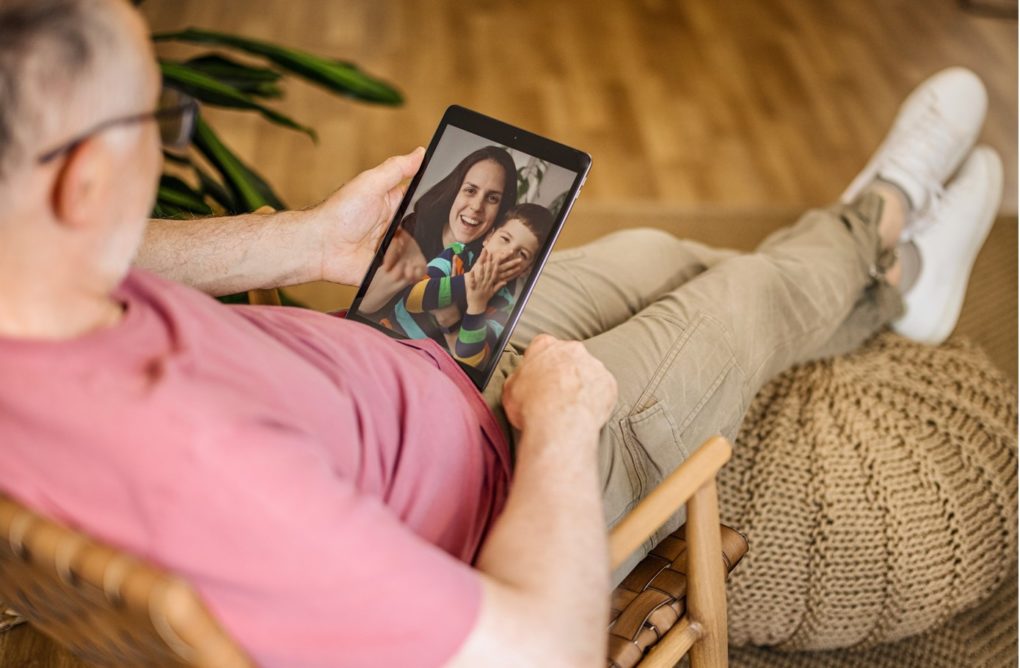Anyone who has been in the position of being a long-distance caregiver will attest to the fact that this is a unique and oftentimes challenging role. The term long-distance is relative; one does not need to be hundreds or thousands of miles away to be considered a long-distance caregiver. If it takes an hour’s drive to reach your friend or family member, you are a long-distance caregiver. The stress created by not feeling present comes in many forms. By calling our Telephone Lifeline or messaging through our Lifeline chat, caregivers can process through these challenges and receive support.
First, there are the financial and logistical challenges inherent in long-distance caregiving. While hands-on caregivers, whether family, friends, neighbors and/or professional caregivers, are a huge help, they need to be coordinated and managed. When this responsibility falls to the long-distance caregiver, it can be a bit overwhelming. Additionally, caregivers at a distance usually try hard to make regular visits. This adds another layer of logistical planning to ensure their own work and responsibilities are covered, such as childcare, pets, etc. The financial burden of providing in-home care and regular travel may be significant.
Another possible source of stress relates to being unable to attend doctor’s visits and treatment appointments in person. As a result, the caregiver at a distance may feel under-informed on disease status and not included in discussions related to treatment decisions. In addition, the long-distance caregiver may struggle with feelings of guilt for not doing more, not being the primary caregiver, or having difficult interactions with their loved one, other family members or other caregivers, creating an emotional toll which adds additional layers of stress.
Below are some suggestions for ways to help manage the stress inherent in providing support from a distance:
Attend medical appointments with a list of questions. Technology is your friend! Being at a distance does not preclude you from being at an appointment. Providers are often able and willing to set up a video visit. Other options are joining by phone through a video chat or speaker. Before the appointment, access information from credible sites such as the National Cancer Institute or the American Cancer Society. Having some background information and exposure to medical jargon will help you prepare a list of questions and get the most out of the visit. Consider recording the visit so you can review what was shared at your own pace after the visit.
Connect with health care providers. Find out who your loved one’s care team includes. The nurses, social workers, and other providers can be valuable sources of information and resources for you. For example, the oncology social workers or nurse navigators can help you get connected to home care services. Make sure all members of the care team know how to reach you.
Organize legal and financial documents. If you are or will be responsible for decision making or are the Power of Attorney for your loved one, be sure you have copies of important documents such as financial information, advanced directives, etc.
Stay connected. Schedule visits with your loved one on a regular basis so they know when you will be connecting with them. Video chat, Zoom, or telephone calls are all options to facilitate that connection. Cards and letters work too! Consider starting a family and friends weekly email update, or use an existing platform such as Caring Bridge, to share information and receive support.
Coordinate social support network. Even though you can’t be there, you can still organize and coordinate your loved one’s care. Online platforms such as Lotsa Helping Hands can guide you to set up a care calendar. If this feels overwhelming, ask a trusted neighbor or friend to set this up for you.
Emotional Support. Getting support for yourself is not an option; it is a must. Schedule time to talk with friends or family who can listen and support you through this experience. Additionally, online support groups, as well as counselors, are available through Cancer Lifeline.
Cancer Lifeline’s FREE Programs and Services for CANCER PATIENTS, SURVIVORS, and CAREGIVERS are here to help you!
Register to join Online Support Groups. Nothing can compare to the feeling of being part of a community of people who truly understand your experience and “get it.” Support groups (all cancers & cancer specific) meet regularly and welcome new members! For dates and times go to the Cancer Lifeline Support Group page on our website. Call the Lifeline or connect through Lifeline Chat. Need someone to listen and help you sort out your feelings? Call the Lifeline at (800) 255-5505 or (206) 297-2500 (9am-5pm). Lifeline Chat can be accessed by clicking the green “We are here to listen” button on any page of our website.
Access Cancer Lifeline’s Cancer-Specific Counseling and Family Support Programs: Contact Pamela Krueger at [email protected] or 206-832-1271
Access Cancer Lifeline’s Therapist Referral Program: Receive names of therapists in the local community who have experience working with people affected by cancer. Referrals and support in choosing a therapist are available for patients, survivors, family members, friends, and oncology professionals. Referrals are free. Cancer Lifeline does not arrange payment with therapists on behalf of clients or check insurance benefits, this is the client’s responsibility. For more information, call the Lifeline at 206-297-2500 between the hours of 9 am- 5 pm or visit: https://cancerlifeline.org/counseling-services/
Access Cancer Lifeline’s presentations and classes (creative expression, exercise and movement, nutrition, and stress reduction) by going to the Cancer Lifeline website or calling the Lifeline: (800) 255-5505 or (206) 297-2500 (M-F 9am-5pm PST.)
You can now participate in our support groups and classes online from the comfort of your home!

